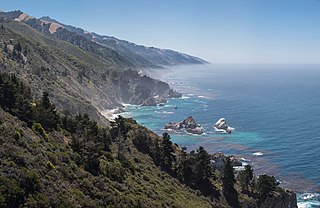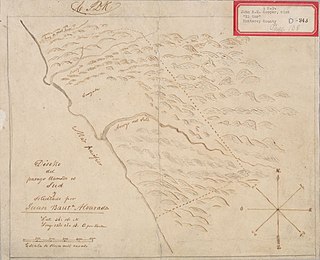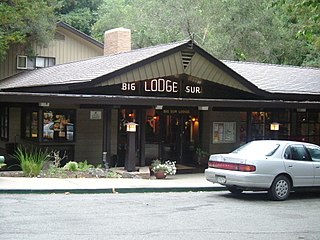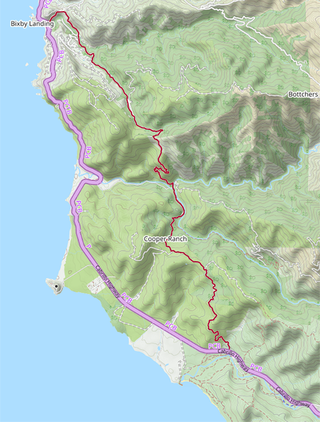Related Research Articles

Big Sur is a rugged and mountainous section of the Central Coast of the U.S. state of California, between Carmel Highlands and San Simeon, where the Santa Lucia Mountains rise abruptly from the Pacific Ocean. It is frequently praised for its dramatic scenery. Big Sur has been called the "longest and most scenic stretch of undeveloped coastline in the contiguous United States", a sublime "national treasure that demands extraordinary procedures to protect it from development", and "one of the most beautiful coastlines anywhere in the world, an isolated stretch of road, mythic in reputation". The views, redwood forests, hiking, beaches, and other recreational opportunities have made Big Sur a popular destination for visitors from across the world. With 4.5 to 7 million visitors annually, it is among the top tourist destinations in the United States, comparable to Yosemite National Park, but with considerably fewer services, and less parking, roads, and related infrastructure.

The Central Coast is an area of California, roughly spanning the coastal region between Point Mugu and Monterey Bay. It lies northwest of Los Angeles and south of the San Francisco Bay Area, and includes the rugged, rural, and sparsely populated stretch of coastline known as Big Sur.

Uvas Canyon County Park is a 1,147-acre (464 ha) natural park located in upper Uvas Canyon on the eastern side of the Santa Cruz Mountains, west of Morgan Hill, California. The park has several small waterfalls, some of which flow perennially, that feed into tributaries confluent with Uvas Creek. The park is part of the Santa Clara County Parks System, and facilitates picnics, hiking and overnight camping. It is one of the few parks in the area that allows dogs in the campgrounds.

Pfeiffer Big Sur State Park is a state park in Monterey County, California, near the area of Big Sur on the state's Central Coast. It covers approximately 1,006 acres (4.07 km2) of land. The park is centered on the Big Sur River. It has been nicknamed a "mini Yosemite." A Redwood tree in the park nicknamed the Colonial Tree is estimated to be between 1,100 and 1,200 years old.
The Big Sur International Marathon is an annual marathon held in California, United States along the Pacific coast. The marathon was established in 1986 and attracts about 4,500 participants annually.

Julia Pfeiffer Burns State Park is a state park in California, 12 miles south of Pfeiffer Big Sur State Park on California's Pacific coast. A main feature of the park is McWay Falls, which drops over a cliff of 80 feet (24 m) into the Pacific Ocean. The park is also home to 300-foot (90 m) redwoods which are over 2,500 years old. The park is named after Julia Pfeiffer Burns, a respected resident and rancher in the Big Sur region in the early 20th century, who lived in the area for much of her life until her death in 1928. The 3,762-acre (1,522 ha) park was established in 1962.
The Pine Ridge Trail is the most popular hiking trail in the Ventana Wilderness of the Los Padres National Forest, California. The 19.5 miles (31.4 km) trail traverses the Ventana Wilderness from the Big Sur Station near sea level to China Camp on Tassajara Road at 5,000 feet (1,500 m). Built in 1916 by the Post family of Big Sur, the Pine Ridge Trail offers hikers and equestrians an array of backcountry camps to enjoy.

Asilomar State Marine Reserve (SMR) is one of four small marine protected areas (MPAs) located near the cities of Monterey and Pacific Grove, at the southern end of Monterey Bay on California’s central coast. The four MPAs together encompass 2.96 square miles (7.7 km2). The SMR protects all marine life within its boundaries. Fishing and take of all living marine resources is prohibited.
Point of Timber is a former settlement in Contra Costa County, California. It was located on Indian Slough 2 miles (3.2 km) north of Byron, and about 2.5 miles east of Union Cemetery in Brentwood. It was originally named Point of Timber Landing. The landing was built by Josiah Wills, who organized the deepening of Indian Slough, connecting the landing to the Old River. Point of Timber got its name from the mile wide strip of open Oak woodland that ran from just east of the house of John Marsh along the course of Arroyo del Sur to the edge of the marshes bordering Indian Slough and Old River.

Rancho El Sur was a 8,949.06-acre (36.22 km2) Mexican land grant in present-day Monterey County, California on the Big Sur coast given in 1834 by Governor José Figueroa to Juan Bautista Alvarado. The grant extended from the mouth of Little Sur River inland about 2.5 miles (4.0 km) over the coastal mountains and south along the coast past the mouth of the Big Sur River to Cooper's Point. In about 1892, the rancho land plus an additional 3,000 acres (1,200 ha) of resale homestead land was divided into two major parcels. The southern 4,800 acres (1,900 ha) became the Molera Ranch, later the foundation of Andrew Molera State Park. The northern 7,100 acres (2,900 ha) form the present-day El Sur Ranch.

Edward F. Ricketts State Marine Conservation Area is one of four small marine protected areas located near the cities of Monterey and Pacific Grove, at the southern end of Monterey Bay on California’s central coast. The four areas together encompass 2.96 square miles (7.7 km2). Within SMCAs fishing and take of all living marine resources is prohibited except the recreational take of finfish by hook-and-line and the commercial take of giant and bull kelp under certain conditions.

Moss Landing Wildlife Area is a California State wildlife preserve on the shore of Elkhorn Slough.
La Vereda del Monte was a backcountry route through remote regions of the Diablo Range, one of the California Coast Ranges. La Vereda del Monte was the upper part of La Vereda Caballo,, used by mesteñeros from the early 1840s to drive Alta California horses to Sonora for sale.

Nepenthe is a restaurant in Big Sur, California, built by Bill and Madelaine "Lolly" Fassett and first opened in 1949. It was built around a cabin first constructed in 1925. It is known for the miles-long panoramic view of the south coast of Big Sur from the outdoor terrace and its California/Greek Mediterranean menu featuring locally and California-grown food.

Ragged Point is a headland on California's Central Coast. It is located at the southern end of Big Sur in northern San Luis Obispo County. The Ragged Point Inn and Resort is located in the area, which, as with much of Big Sur, features seaside cliffs, beaches, and hiking trails.

Big Sur Coast Highway is a section of California State Route 1 through the Big Sur region of California that is widely considered to be one of the most scenic driving routes in the United States, if not the world. It is both a National Scenic Highway and a California Scenic Highway, and was described by Australian painter Francis McComas as the "greatest meeting of land and water in the world". Condé Nast Traveler named State Route 1 through Big Sur one of the top ten world-famous streets, comparable to Broadway in New York City and the Champs-Élysées in Paris. The road itself is a destination for visitors.
Glen Deven Ranch is an 860 acres (350 ha) property in Big Sur that was given to the Big Sur Land Trust in 2001 by Seeley and Virginia Mudd. Composed of coastal woodlands, coastal river lands, grasslands and wildlife, it is used by the Trust each summer as an outdoor summer camp to teach inner-city youth about coastal ecosystems. The ranch is accessible via Highway 1 east on Palo Colorado Road, to Garrapatos Road. The ranch's roads also offer residents of Palo Colorado Canyon an emergency exit during a flood or fire.

Big Sur Village is an unincorporated community in the Big Sur region, in Monterey County, California, United States. It is located along a 1-mile-long (1.6 km) stretch of Big Sur Coast Highway in the Big Sur Valley 24 miles (39 km) south of Carmel, California. The village contains the largest collection of shops and visitor services along the entire 71-mile (114 km) segment of California State Route 1 between Malpaso Creek near Carmel Highlands in the north and San Carpóforo Creek near San Simeon in the south. The population of the entire coastal region is about 1,463. The collection of small roadside businesses and homes is often confused with the larger region, also known as Big Sur. On March 6, 1915, United States Post Office granted the English-speaking residents' request to change the name of their post office from Arbolado to Big Sur. Caltrans also refers to the village as Big Sur.

The Old Coast Road is a dirt road that still exists in part and preceded the current Big Sur Coast Highway along the northern coast of Big Sur, California. It was initially a trail created by Rumsen and Esselen Native Americans to travel along the coast in present-day Monterey County, California. Soon after the Spanish arrived, Governor Teodoro Gonzalez granted land that included portions of the trail as Rancho San Jose y Sur Chiquito to Marcelino Escobar in 1835. Governor Juan Alvarado re-granted the land to Escobar the same year. The Rancho included land from Carmel to near Palo Colorado Canyon. José Castro gained possession of the land in about 1848. He improved the trail from Monterey to Palo Colorado Canyon as early as 1853. A hand-drawn map created c. 1853 accompanying the grant indicated a road or trail was already present along the coast.
References
- ↑ Brekke, Dan (July 18, 2018). "Highway 1 Is Open Again, 14 Months After Epic Big Sur Slide". KQED . Retrieved February 4, 2024.
- ↑ Copitch, Josh (May 4, 2023). "Popular Big Sur trail reopens after closing from storm damage". KSBW . Retrieved February 4, 2024.
36°14′52″N121°46′55″W / 36.24772°N 121.78191°W
